Discover the top 12 business process automation tools for 2025. Our guide covers features, pros, cons, and use cases to help you choose the right solution.
July 26, 2025 (4mo ago)
12 Best Business Process Automation Tools for 2025
Discover the top 12 business process automation tools for 2025. Our guide covers features, pros, cons, and use cases to help you choose the right solution.
← Back to blog
In today's competitive business environment, efficiency is not just an advantage; it's a core component of survival and growth. Repetitive, manual tasks drain valuable resources, introduce human error, and pull focus away from critical strategic initiatives. This is precisely the problem that business process automation tools** are designed to solve, transforming operations by automating workflows across every department.
From finance and HR to marketing and sales, the right BPA software can unlock significant productivity gains, reduce operational costs, and boost organizational agility. But with a market saturated with options, identifying the ideal solution for your unique needs can be a challenge. To truly grasp the impact and versatility of these tools, it's beneficial to explore real-world business process automation examples that demonstrate their application across various industries.
This comprehensive guide is built to cut through the marketing noise. We provide a detailed analysis of the top platforms, moving beyond generic feature lists to offer practical insights, honest assessments, and specific use cases. Each review includes screenshots and direct links to help you evaluate your options effectively. Whether you're a startup founder seeking a simple no-code solution or an enterprise leader needing a scalable RPA platform, this resource will equip you to make an informed decision.
1. Fluidwave
Fluidwave positions itself as a premier choice among business process automation tools by uniquely merging AI-driven task management with a human-powered delegation network. It’s engineered for professionals who need to not only organize their own workflows but also effectively offload tasks to skilled assistants. This dual-focus on intelligent automation and practical delegation sets it apart in a crowded market.
The platform’s core strength lies in its AI that automates task prioritization, helping users maintain focus on high-impact activities. Its distraction-free interface, designed with neurodivergent users in mind, further enhances productivity by minimizing cognitive load. While many tools offer automation, Fluidwave extends this concept by connecting users to a network of virtual assistants on a pay-per-task basis, eliminating the need for costly monthly subscriptions. This model provides scalable support for anyone from solo entrepreneurs to larger teams.
Key Features & Analysis
- AI Auto-Prioritization: Automatically organizes your task list based on urgency and importance, saving significant time on manual planning.
- Flexible Views: Switch between Kanban, list, table, calendar, and card views to match your preferred workflow, ensuring adaptability for diverse projects.
- Pay-Per-Task Delegation: Its standout feature connects you with human virtual assistants without a subscription commitment, offering a cost-effective way to scale your output. Explore more about how this system transforms productivity by reading their guide on delegation software.
- Generous Free Tier: Fluidwave offers a comprehensive free plan that includes AI features, integrations, and unlimited workspaces, making it highly accessible. A one-time payment of $34.95 removes ads for a premium experience.
Pros:
- AI-powered prioritization simplifies workload management.
- Pay-per-task delegation is a cost-effective alternative to subscriptions.
- Distraction-free UI is excellent for deep focus.
- Robust features are available on the free plan.
Cons:
- The human delegation feature is still in development ("coming soon").
- The one-time premium upgrade primarily removes ads, which may not appeal to all users.
2. UiPath
UiPath stands as a formidable leader in the Robotic Process Automation (RPA) space, offering a robust platform designed to automate repetitive, rules-based tasks across diverse business functions. It empowers organizations to build and deploy software "bots" that mimic human actions, interacting with digital systems and software just as a person would. This makes it an exceptional choice for legacy system integration where APIs are unavailable, or for automating high-volume, data-intensive processes like invoice processing or data entry.
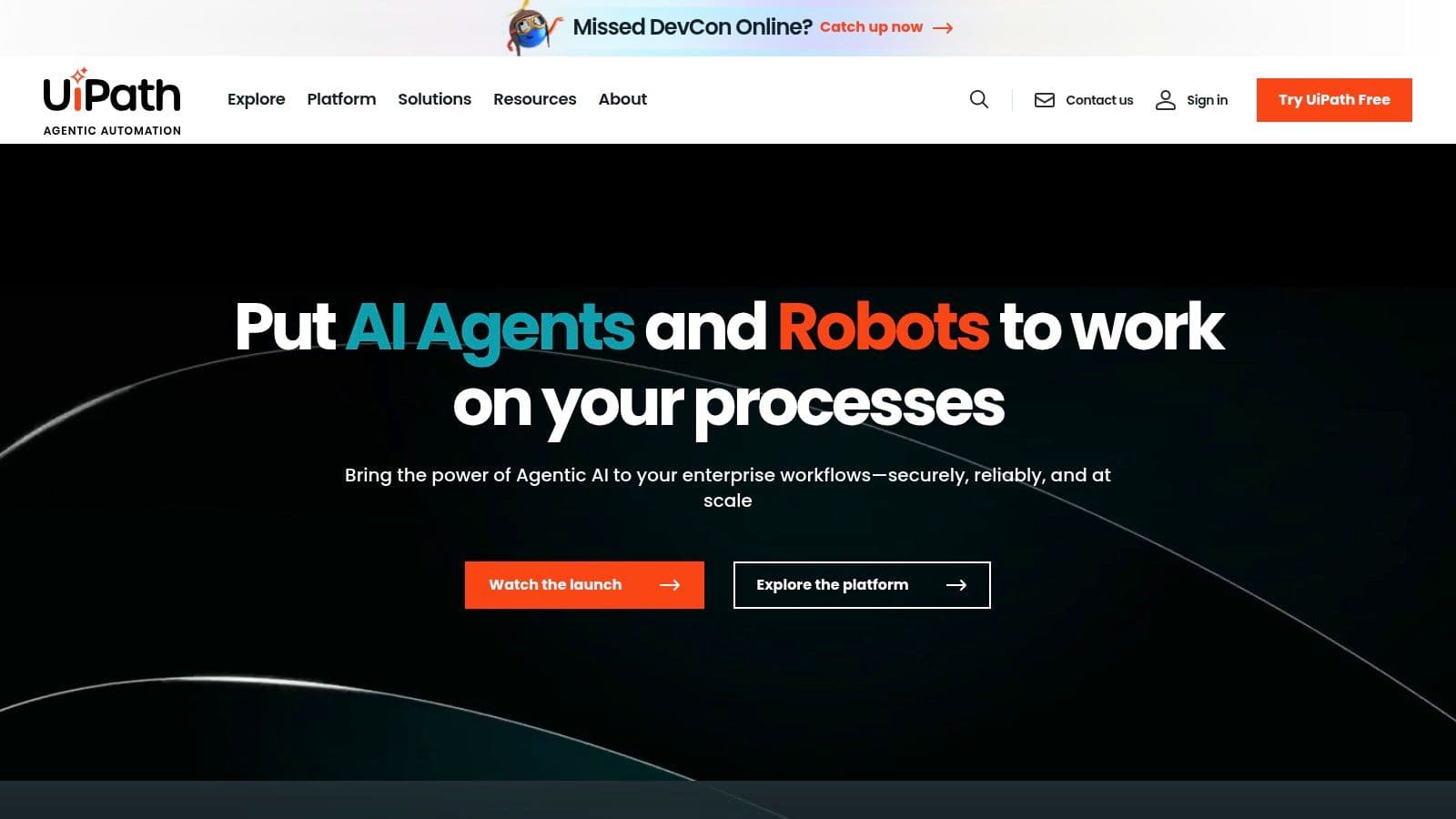
What sets UiPath apart is its scalability and extensive feature set, which includes AI and machine learning capabilities for handling more complex, cognitive tasks. While its drag-and-drop interface is user-friendly for basic automation, mastering its advanced features presents a steeper learning curve.
Key Features & Considerations
| Feature/Aspect | Details |
|---|---|
| Best For | Enterprise-level deployment, automating legacy systems, finance, and HR departments. |
| Pricing | Offers a free Community Edition for individuals and small teams. Pro and Enterprise plans are quote-based and can be a significant investment. |
| Pros | Highly versatile and scalable, strong community support with extensive learning resources, powerful AI and analytics integration. |
| Cons | Advanced features require significant technical expertise, and enterprise-level pricing can be prohibitive for smaller businesses. |
Practical Tip: Start with UiPath's free Community Edition and leverage their extensive online Academy to train a team member on a specific, high-impact automation project before committing to an enterprise plan.
Website: https://www.uipath.com/
3. Microsoft Power Automate
As a core component of the Microsoft Power Platform, Power Automate excels at creating automated workflows that seamlessly connect disparate applications and services. It is particularly powerful for businesses already invested in the Microsoft ecosystem, offering deep, native integration with products like Microsoft 365, Dynamics 365, and Azure. This makes it one of the most effective business process automation tools for tasks like syncing files, collecting data, or automating approval processes within a familiar environment.
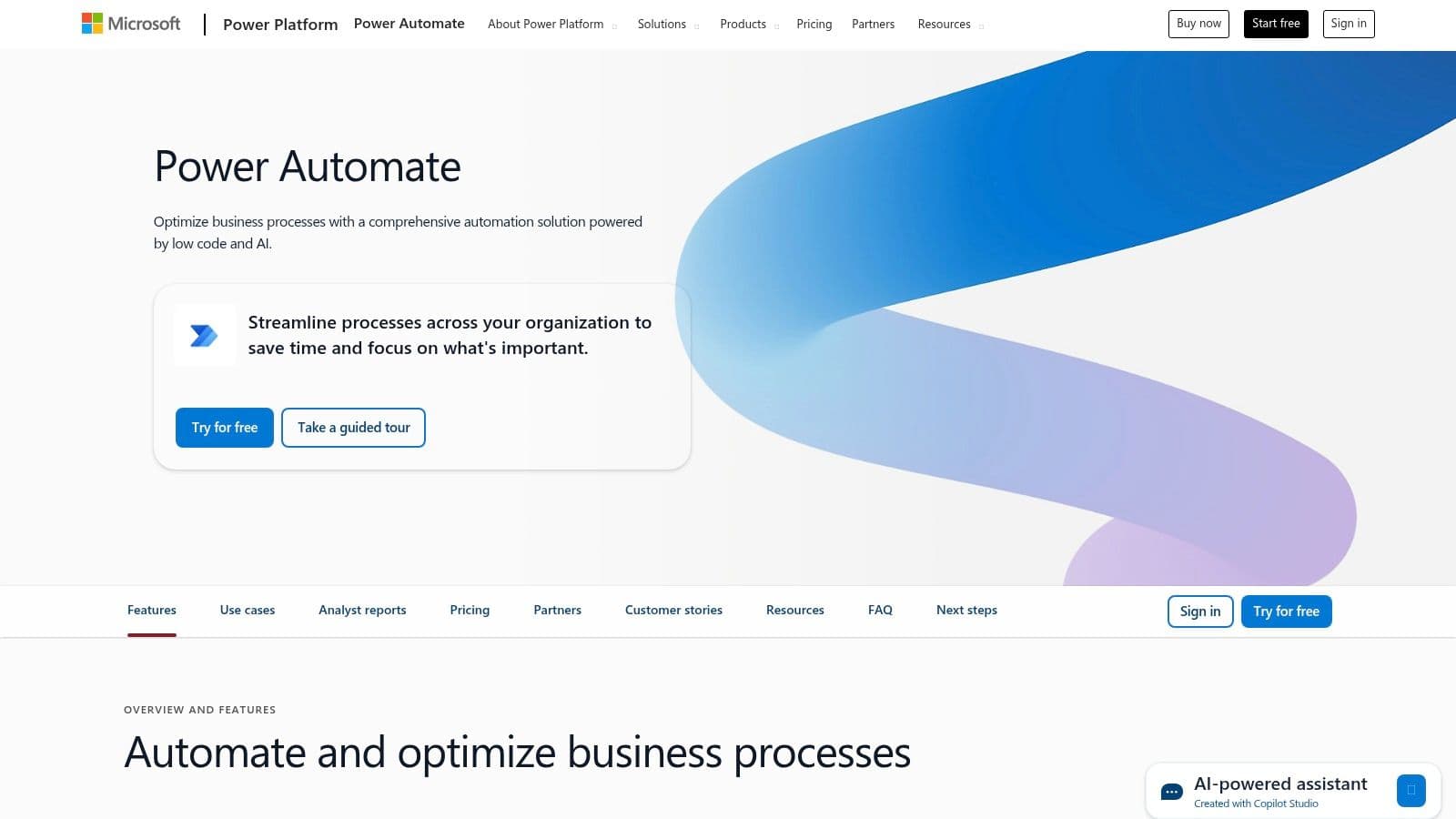
What distinguishes Power Automate is its accessibility and vast library of pre-built templates, which empower non-technical users to build useful automations quickly. Its cloud-based nature and integrated AI Builder also provide a scalable path from simple task automation to more complex, intelligent workflows. To see how it can be applied, you can explore workflow automation for small business.
Key Features & Considerations
| Feature/Aspect | Details |
|---|---|
| Best For | Organizations heavily using Microsoft products, automating Office 365 tasks, and empowering citizen developers. |
| Pricing | Included in many Microsoft 365 plans. Per-user and per-flow plans offer flexibility, with premium connectors requiring paid tiers. |
| Pros | Exceptional integration with the Microsoft suite, user-friendly interface with many templates, flexible and scalable pricing models. |
| Cons | Functionality can be limited when connecting to services outside the Microsoft ecosystem, and advanced features can have a learning curve. |
Practical Tip: Start by exploring the built-in templates within your existing Microsoft 365 subscription. Automate a simple, personal task first, like saving email attachments to OneDrive, to understand the platform's logic before tackling larger team-based workflows.
Website: https://powerautomate.microsoft.com/
4. Automation Anywhere
Automation Anywhere provides an intelligent, cloud-native Robotic Process Automation (RPA) platform designed for enterprise-grade scalability. It excels at combining traditional RPA with AI and machine learning, enabling businesses to automate complex, end-to-end processes far beyond simple task repetition. This makes it a powerful contender among business process automation tools for organizations looking to digitize operations across multiple departments like finance, supply chain, and customer service.
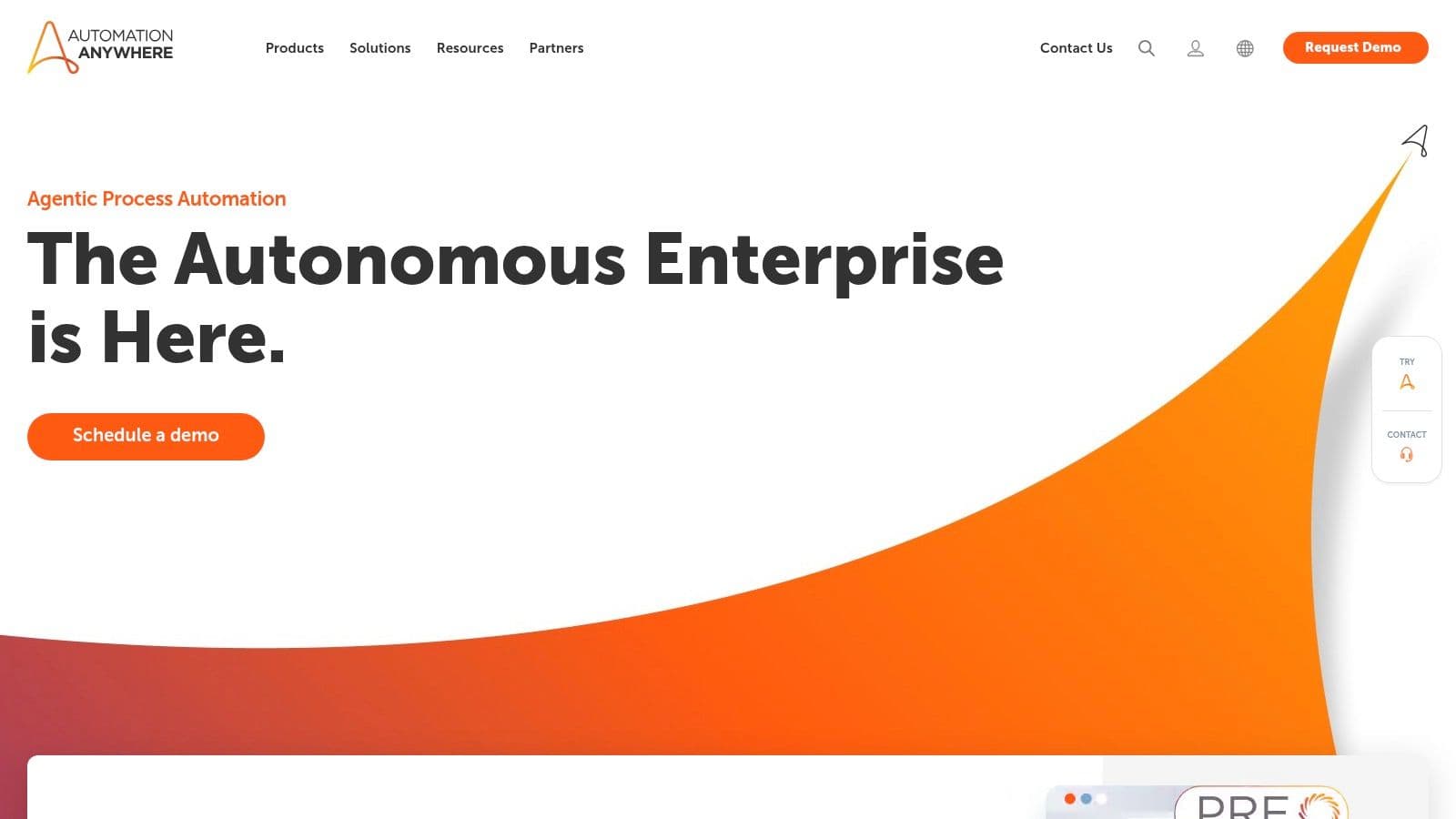
The platform is recognized for its user-friendly, web-based interface that requires minimal coding, making automation accessible to a broader range of business users. Its emphasis on a "digital workforce" composed of AI-powered bots allows for flexible and secure deployment, whether on-premise or in the cloud, to meet diverse security and infrastructure requirements.
Key Features & Considerations
| Feature/Aspect | Details |
|---|---|
| Best For | Enterprise-wide automation initiatives, cloud-first companies, and automating processes requiring AI. |
| Pricing | Quote-based. Pricing information is not publicly available and requires direct contact with their sales team. |
| Pros | User-friendly interface with low-code/no-code options, flexible cloud or on-premise deployment, strong customer support. |
| Cons | Initial setup for large-scale deployments can be complex, and the lack of transparent pricing makes it difficult to budget without a sales call. |
Practical Tip: Leverage their "Bot Store," an online marketplace for pre-built bots. This can significantly accelerate your automation journey by providing ready-to-deploy solutions for common tasks, reducing development time and effort.
Website: https://www.automationanywhere.com/
5. Blue Prism
Blue Prism is a powerhouse in the RPA landscape, delivering an enterprise-grade platform that emphasizes security, compliance, and scalability. It provides a "digital workforce" designed to operate within the most stringent IT governance and security frameworks, making it a top choice for highly regulated industries like banking, insurance, and healthcare. Its architecture is built for secure, centrally managed automation, ensuring that processes adhere to strict compliance protocols.
What distinguishes Blue Prism is its robust, code-free approach combined with powerful control room features for managing a large-scale deployment of digital workers. This focus on centralized management and security makes it one of the premier business process automation tools for organizations where data integrity and auditability are non-negotiable. While powerful, this enterprise focus means it can present a steeper learning curve than some more accessible platforms.
Key Features & Considerations
| Feature/Aspect | Details |
|---|---|
| Best For | Large enterprises in regulated industries, mission-critical process automation, and IT-led automation initiatives. |
| Pricing | Quote-based, enterprise-level licensing. Typically represents a significant investment aimed at large-scale deployments. |
| Pros | Exceptional security and governance features, highly scalable architecture, comprehensive control and audit capabilities, strong support resources. |
| Cons | Can have a higher total cost of ownership, and the learning curve is steeper, often requiring dedicated developer training. |
Practical Tip: Engage your IT and compliance teams early when considering Blue Prism. Use its process assessment tools to identify a high-value, complex process that can serve as a strong business case for the platform's security and scalability benefits.
Website: https://www.blueprism.com/
6. Appian
Appian positions itself as a low-code automation platform that excels at unifying data, people, and processes. It enables organizations to rapidly design, automate, and optimize complex end-to-end business workflows. This makes it particularly powerful for industries like finance, pharmaceuticals, and government, where intricate processes and strict regulatory compliance are non-negotiable. Appian goes beyond simple task automation by providing a comprehensive suite for building enterprise-grade applications.
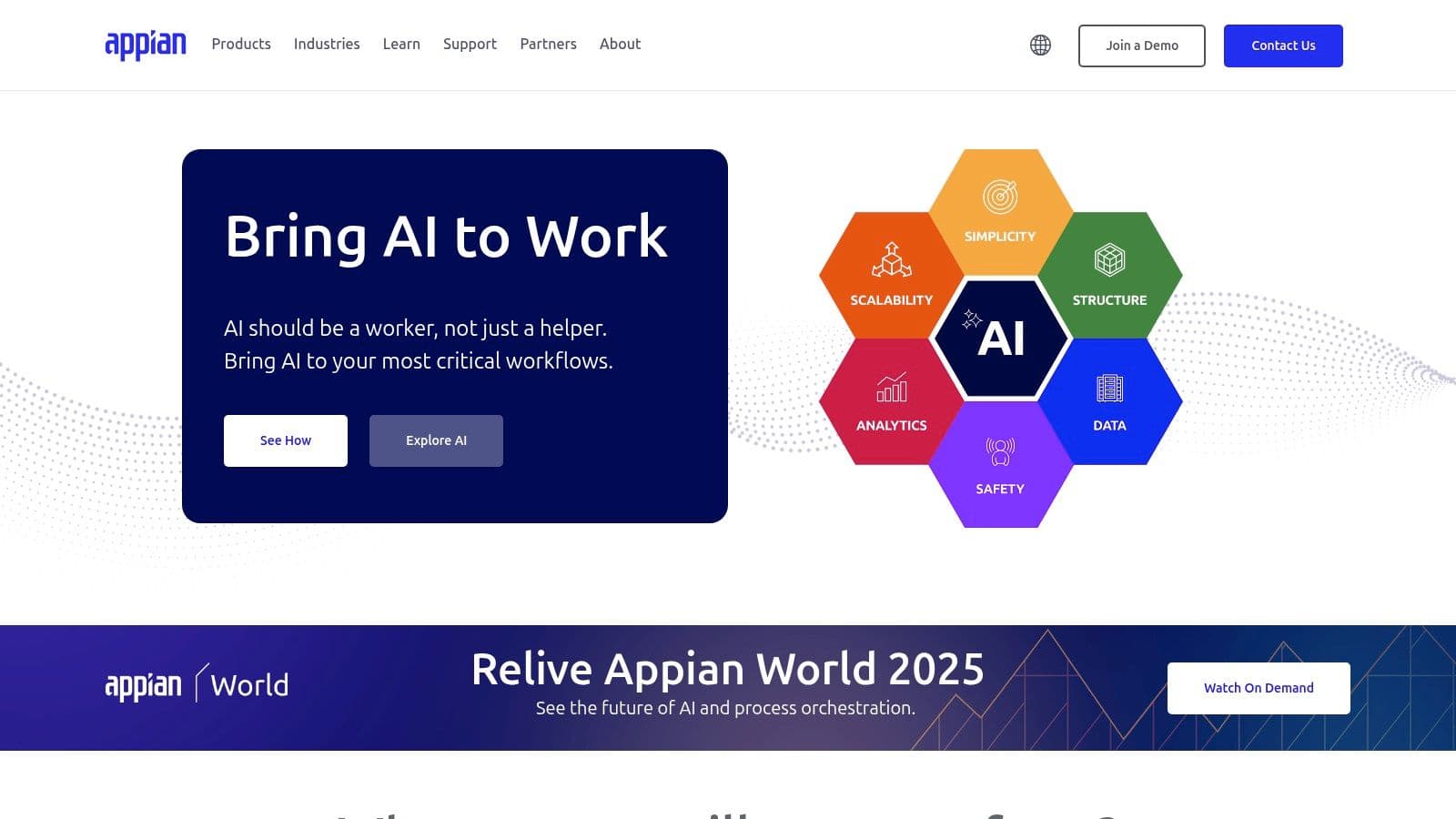
What differentiates Appian is its holistic approach to process management, combining workflow, AI, and RPA within a single, unified architecture. While its low-code environment accelerates development, unlocking the platform's full potential for highly customized, mission-critical applications often requires specialized training. It stands as one of the most robust business process automation tools for large-scale, complex digital transformation initiatives.
Key Features & Considerations
| Feature/Aspect | Details |
|---|---|
| Best For | Enterprise-level case management, regulated industries, and developing complex, custom business applications. |
| Pricing | Offers a free edition with limited features. Standard and enterprise plans are quote-based, reflecting its focus on large-scale deployments. |
| Pros | Rapid application development and deployment, excellent for complex and regulated workflows, strong integration capabilities. |
| Cons | Enterprise plans represent a significant financial commitment, and mastering advanced features can have a steep learning curve. |
Practical Tip: Use Appian's free edition to build a proof-of-concept for a single, complex departmental workflow. This allows you to evaluate its low-code interface and process modeling capabilities before engaging with sales for an enterprise-wide solution.
Website: https://www.appian.com/
7. Nintex
Nintex offers a powerful and intuitive platform for managing, automating, and optimizing business processes. It excels in workflow automation and document generation, enabling organizations to quickly digitize manual tasks, from simple approvals to complex, multi-stage workflows. The platform is particularly well-regarded for its deep integration with the Microsoft ecosystem (SharePoint, Office 365), making it a natural fit for companies already invested in those tools.
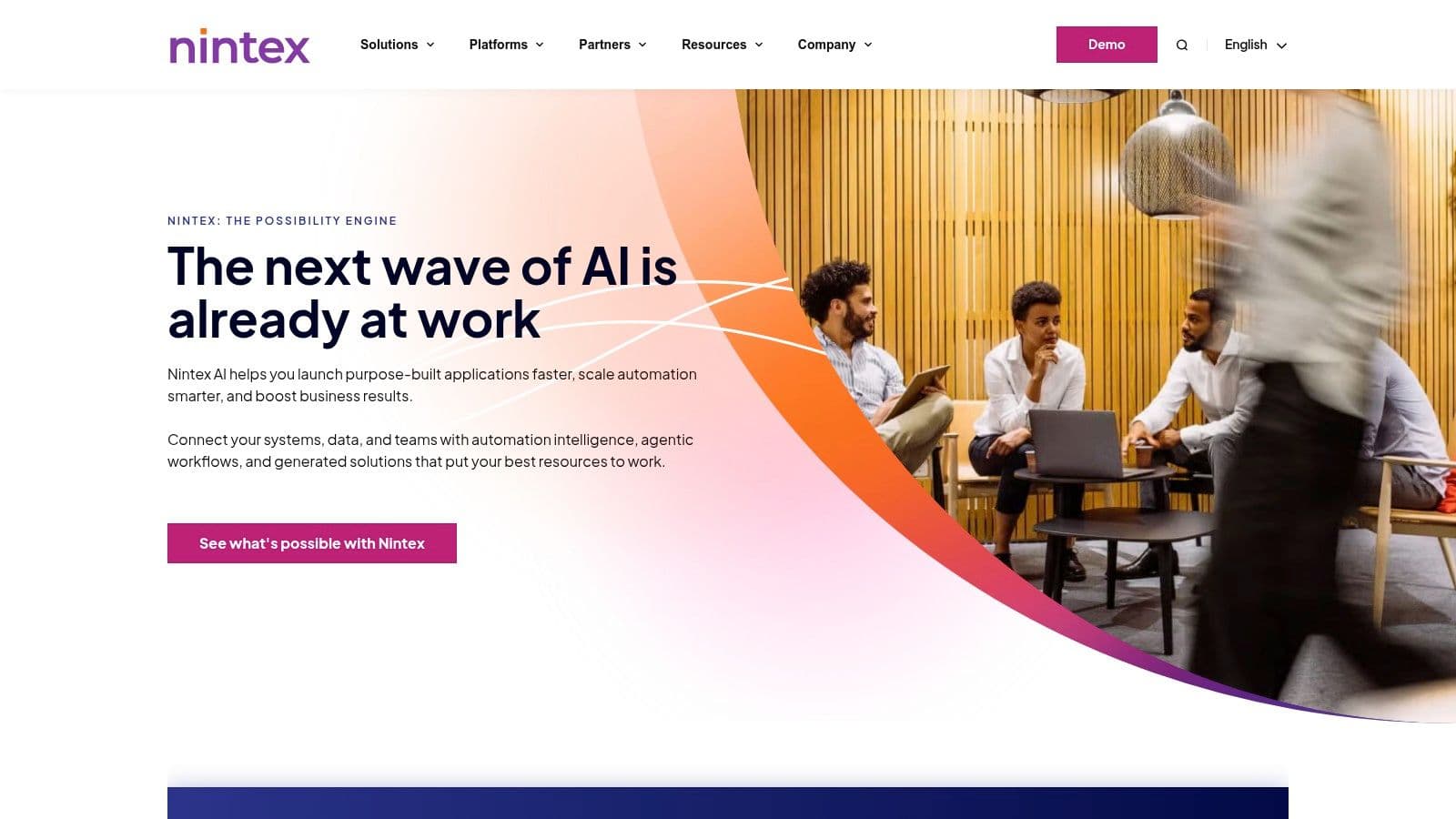
What distinguishes Nintex is its user-friendly, visual workflow designer that empowers business users, not just developers, to build and deploy automations. This focus on low-code/no-code accessibility helps accelerate digital transformation across an entire organization. Among the various business process automation tools, Nintex stands out for its comprehensive suite that includes process mapping, e-signatures, and robotic process automation (RPA).
Key Features & Considerations
| Feature/Aspect | Details |
|---|---|
| Best For | Organizations heavily using Microsoft products, contract management, HR onboarding, and empowering non-technical users. |
| Pricing | Quote-based. Pricing is customized based on usage, features, and number of workflows, requiring direct contact with sales. |
| Pros | Highly intuitive visual designer, strong native integrations (especially with Microsoft), and excellent document automation capabilities. |
| Cons | Pricing is not transparent and can be complex. Advanced customization may still require some technical expertise. |
Practical Tip: Leverage the Nintex Process Manager tool first to visually map out a critical business process. This creates a clear blueprint, making the subsequent automation build within the Workflow Cloud much more efficient and effective.
Website: https://www.nintex.com/
8. Zapier
Zapier is the quintessential "glue" of the internet, a no-code automation platform renowned for its simplicity and vast connectivity. It allows users to connect over 7,000 different web applications and automate workflows between them with simple "if this, then that" logic. This makes it one of the most accessible business process automation tools for non-technical users, perfect for automating routine tasks like adding new leads from a form to a CRM, posting social media updates, or creating calendar events from emails.
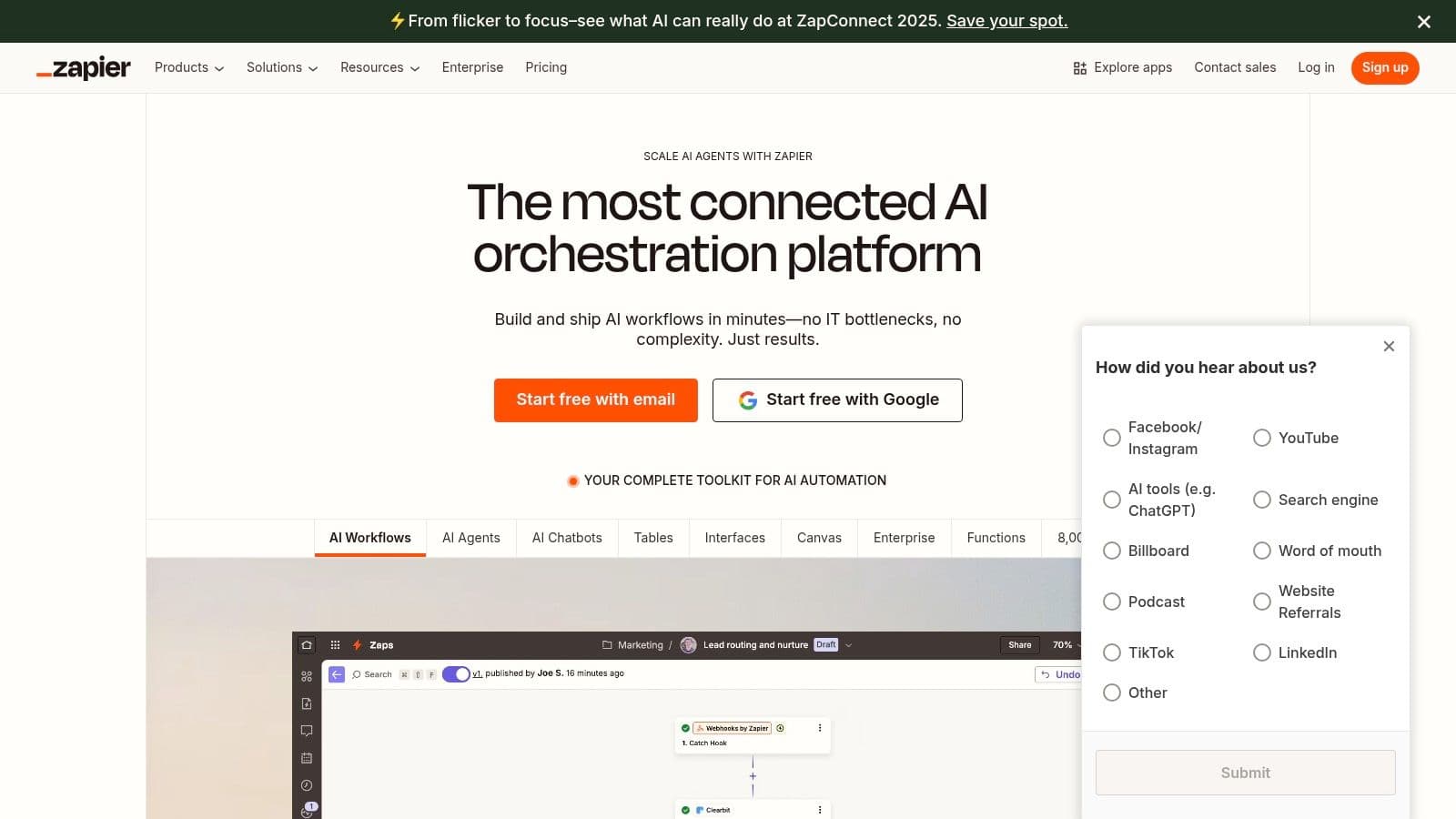
What truly distinguishes Zapier is its unparalleled app ecosystem and ease of use. While it may not handle the complex, enterprise-level logic of RPA platforms, its strength lies in empowering anyone to build powerful, multi-step automations (called "Zaps") in minutes. This rapid implementation cycle is ideal for small to mid-sized teams looking for immediate efficiency gains without a steep learning curve or development resources.
Key Features & Considerations
| Feature/Aspect | Details |
|---|---|
| Best For | Small to mid-sized businesses, marketing and sales teams, freelancers, and non-technical users. |
| Pricing | Offers a free plan with limited Zaps. Paid plans scale based on the number of tasks and features, starting from around $19.99/month. |
| Pros | Extremely user-friendly with a clean interface, massive library of app integrations, fast to set up and deploy automations. |
| Cons | Can become expensive as task volume increases, limited capabilities for highly complex or conditional logic. |
Practical Tip: Start by identifying a repetitive, low-stakes task, like saving email attachments to a cloud drive. Use Zapier's free plan to build this simple automation and understand the platform's core mechanics before investing in a paid plan for more critical, multi-step workflows.
Website: https://zapier.com/
9. Kissflow
Kissflow is a unified work platform designed to empower non-technical business users with the ability to create, modify, and manage automated processes. It positions itself as a no-code/low-code solution, making it one of the most accessible business process automation tools for organizations looking to digitize operations without a heavy reliance on IT departments. Its core strength lies in its intuitive, visual workflow builder that allows users to map out processes like employee onboarding, purchase requests, or help desk tickets with drag-and-drop simplicity.
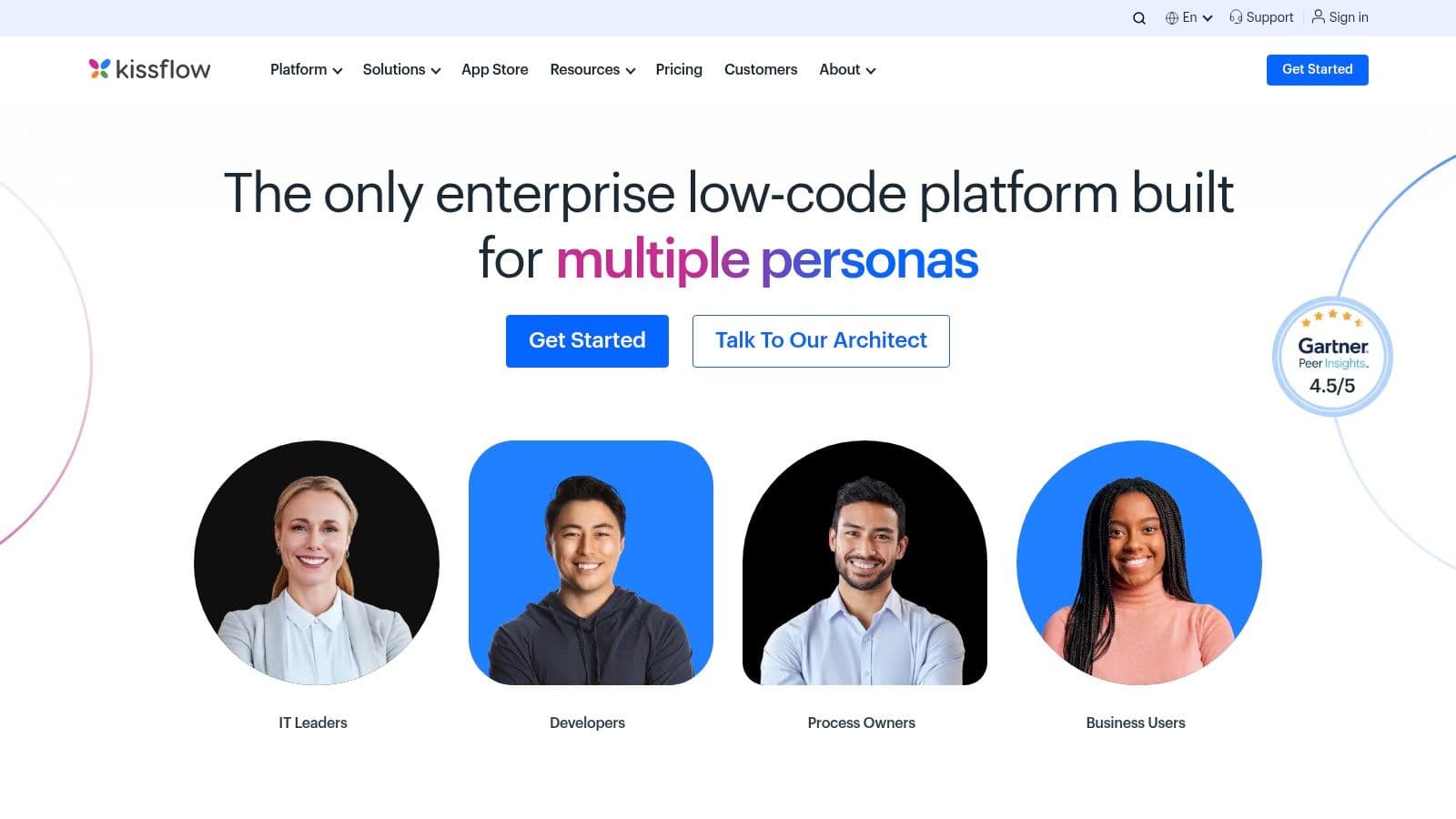
What differentiates Kissflow is its focus on citizen development, democratizing process automation across the entire organization. While it may not have the deep, complex customization options of enterprise-grade platforms, its speed of deployment and user-friendliness are unparalleled for departments needing quick solutions.
Key Features & Considerations
| Feature/Aspect | Details |
|---|---|
| Best For | Departments like HR, Finance, and IT in small to medium-sized businesses; companies aiming for rapid process digitization. |
| Pricing | Offers several tiers, starting with a Small Business plan. A free trial is available, with pricing generally considered affordable for SMBs. |
| Pros | Extremely user-friendly for non-technical staff, rapid implementation of new workflows, and strong process analytics and reporting tools. |
| Cons | The integration library is less extensive than some competitors, and it may lack the advanced customization needed for highly complex enterprise processes. |
Practical Tip: Use Kissflow's pre-built templates for common processes like invoice approval or vacation requests as a starting point. This allows your team to get a functional automation up and running in hours, not weeks, and then customize it to fit your specific needs.
Website: https://kissflow.com/
10. Pipefy
Pipefy excels as a no-code business process automation tool that empowers non-technical teams to design, manage, and automate their workflows. It utilizes a highly visual, Kanban-style interface that makes tracking tasks and process stages incredibly intuitive. This platform is ideal for standardizing and automating structured processes like employee onboarding, client intake, or IT helpdesk requests, where clear steps and approvals are essential for efficiency and consistency.
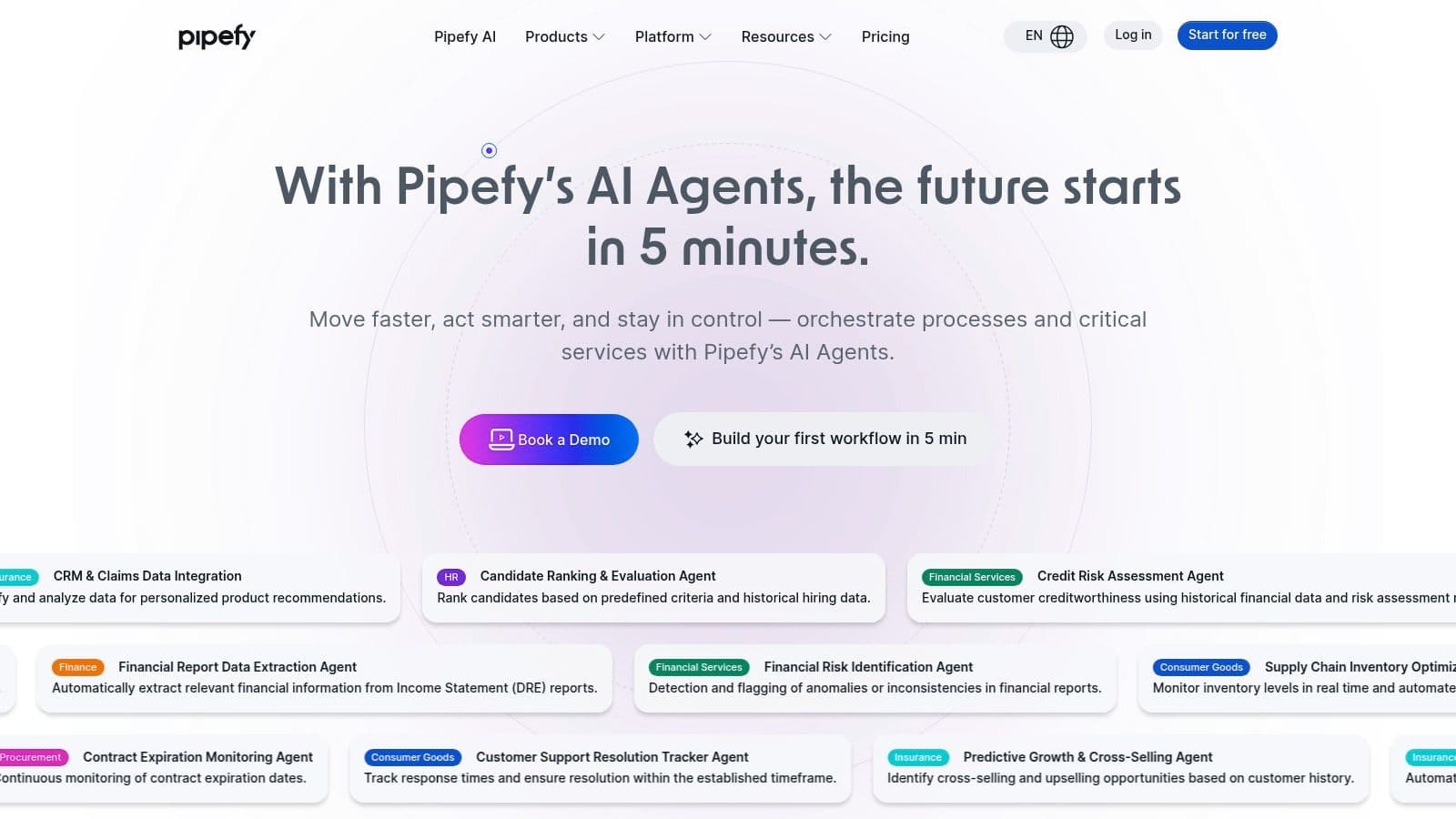
What distinguishes Pipefy is its blend of user-friendliness and process control. Teams can quickly build and deploy workflows using pre-built templates, while managers maintain oversight with powerful reporting and analytics. Although its automation rules are straightforward, they may feel limited for highly complex, multi-system orchestrations compared to dedicated RPA or iPaaS solutions.
Key Features & Considerations
| Feature/Aspect | Details |
|---|---|
| Best For | Human-centric workflows like HR, customer service, and finance requests in small to mid-sized businesses. |
| Pricing | Offers a free plan for small teams. Paid plans start with a Business tier and include an Enterprise option with quote-based pricing. |
| Pros | Very intuitive visual interface, fast to deploy new workflows with templates, solid integration capabilities for common business apps. |
| Cons | Advanced customization and logic can be limited, and mastering complex automation rules may require additional training. |
Practical Tip: Start with Pipefy's free plan and a pre-built template for a common process like "Purchase Requisitions." This allows your team to experience the platform's value and user interface firsthand before investing in a paid plan for more extensive automation.
Website: https://www.pipefy.com/
11. Laserfiche
Laserfiche excels as an intelligent content management and business process automation platform, focusing on digitizing documents and automating workflows around them. It is designed for organizations looking to transform their paper-heavy processes into secure, efficient digital operations. The platform enables businesses to capture, manage, and access documents digitally, which significantly boosts productivity, ensures regulatory compliance, and improves information governance.
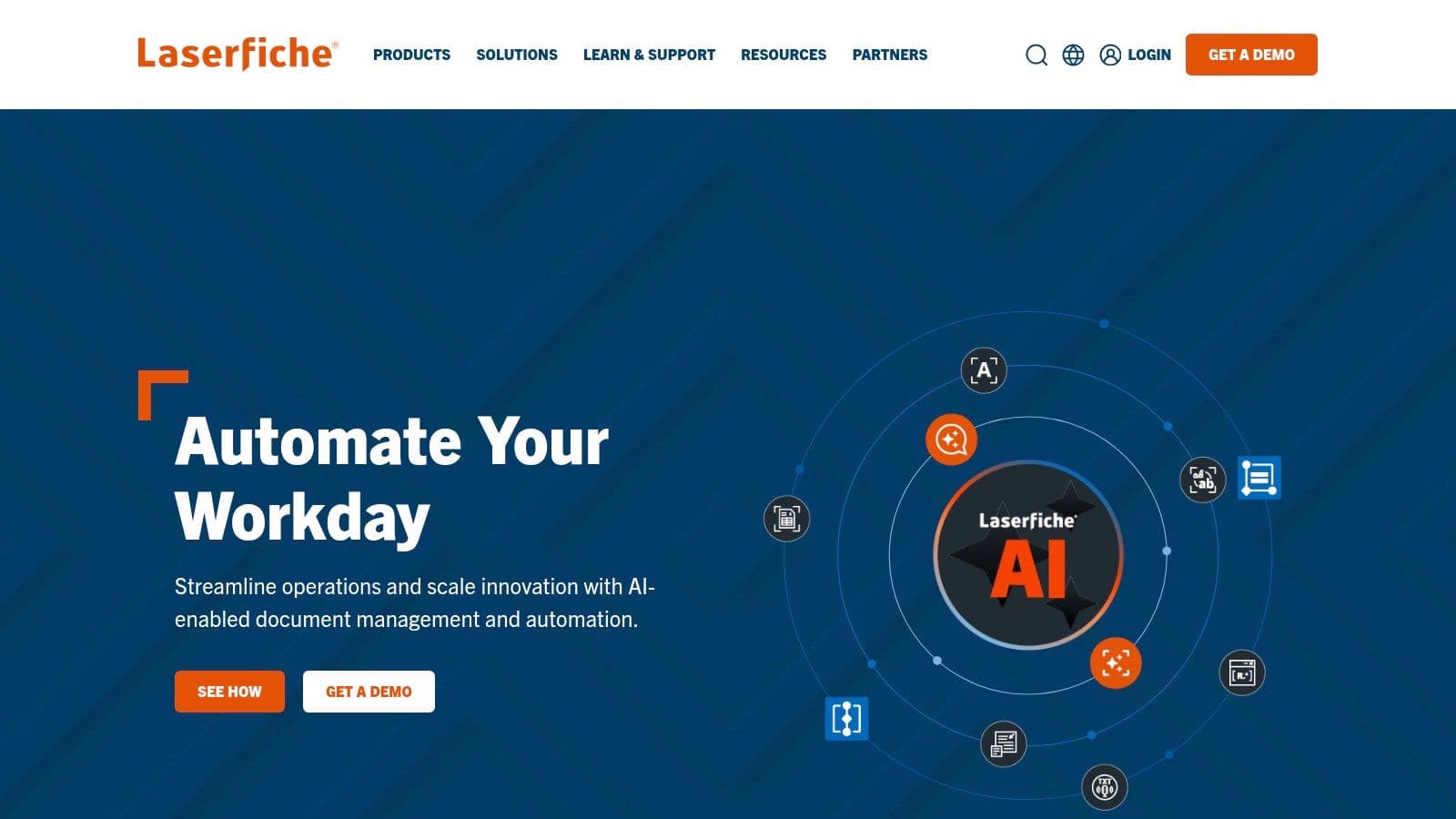
What distinguishes Laserfiche is its deep focus on the entire document lifecycle, from capture to archival, integrated with powerful workflow automation. While it offers user-friendly tools for basic tasks, unlocking its full potential for complex, organization-wide process automation requires dedicated training and a strategic implementation approach, making it a robust choice among business process automation tools for document-centric industries.
Key Features & Considerations
| Feature/Aspect | Details |
|---|---|
| Best For | Government, education, and financial services; departments heavy on compliance and records management. |
| Pricing | Pricing is quote-based and requires direct contact with their sales team. Available as both cloud and on-premises solutions. |
| Pros | Powerful document and records management, flexible deployment options (cloud/on-prem), comprehensive support, and training resources. |
| Cons | Pricing is not transparent, and leveraging its advanced workflow and administration features often requires significant training. |
Practical Tip: Start by identifying one critical paper-based process, such as HR onboarding or accounts payable, and use a Laserfiche solution provider to help map and automate it. This proves the concept and builds internal expertise before a broader rollout.
Website: https://www.laserfiche.com/
12. Workato
Workato serves as an intelligent, enterprise-grade integration platform as a service (iPaaS) that excels at connecting a vast ecosystem of applications and automating complex, end-to-end business processes. It's designed to empower both business users and IT specialists to build powerful workflows, or "recipes," that can sync data, trigger actions across multiple cloud apps, and orchestrate sophisticated logic. This makes it an ideal choice for businesses seeking to break down data silos and create a unified, automated operational backbone.
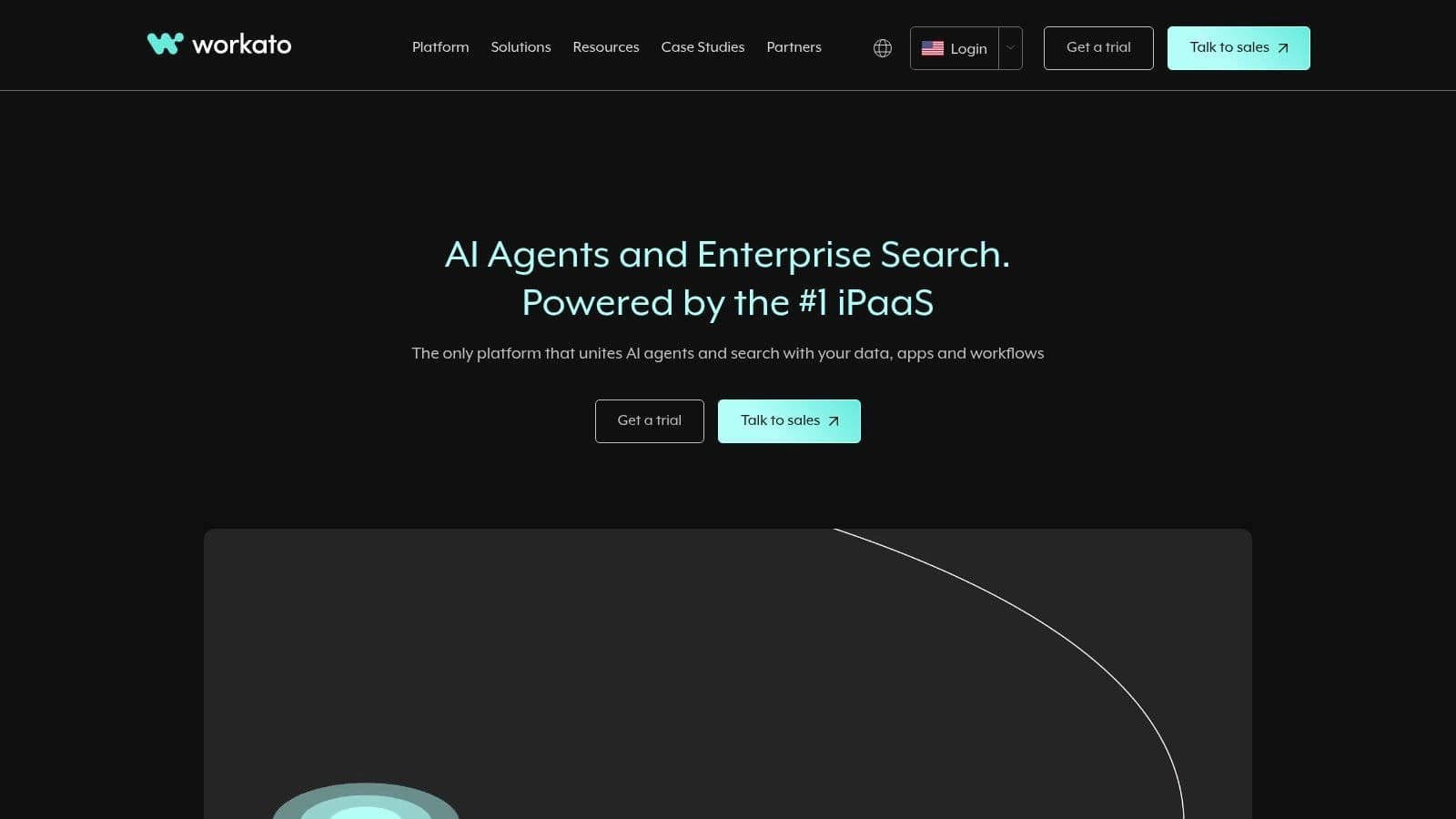
What distinguishes Workato is its collaborative, low-code/no-code environment combined with robust, enterprise-level governance and security. This dual focus allows departments like sales, marketing, and HR to build their own automations while IT maintains full visibility and control, making it one of the most versatile business process automation tools for scaling organizations.
Key Features & Considerations
| Feature/Aspect | Details |
|---|---|
| Best For | Enterprise-wide automation, creating complex cross-departmental workflows, and integrating hundreds of cloud applications. |
| Pricing | Quote-based pricing tailored to specific business needs and recipe usage. Generally positioned for mid-to-large companies. |
| Pros | Immense library of connectors, powerful and scalable architecture, designed for collaboration between business and IT teams. |
| Cons | Pricing structure can be a significant investment for small businesses, and building highly complex recipes may require technical expertise. |
Practical Tip: Leverage Workato's community-driven library of pre-built "recipes" to accelerate your initial automation projects. Start with a common process, like lead-to-cash or employee onboarding, to see immediate value before designing custom workflows from scratch.
Website: https://www.workato.com/
Top 12 Business Process Automation Tools Comparison
| Platform | Core Features/Characteristics | User Experience/Quality ★ | Value Proposition 💰 | Target Audience 👥 | Unique Selling Points ✨ |
|---|---|---|---|---|---|
| 🏆 Fluidwave | AI-driven task management, multi-view, virtual assistants | ★★★★☆ distraction-free, AI workflows | Free tier + pay-per-task delegation | Busy professionals, freelancers, teams | Pay-as-you-go human assistants, deep focus |
| UiPath | RPA, AI/ML integration, scalable enterprise | ★★★★ intuitive drag-and-drop | Free & premium plans | Enterprises, industries | Extensive component library |
| Microsoft Power Automate | RPA, AI Builder, Microsoft ecosystem integration | ★★★★ user-friendly | Flexible pricing | Microsoft suite users, enterprises | Deep MS integration |
| Automation Anywhere | Cloud-native RPA, AI-powered bots | ★★★★ easy use, minimal coding | Contact sales | Enterprises across industries | Industry-specific bots |
| Blue Prism | Secure, scalable enterprise RPA | ★★★★ strong security | Higher cost | Regulated industries | Robust compliance and control |
| Appian | Low-code automation, process modeling | ★★★★ rapid deployment | Higher enterprise cost | Complex workflows, regulated sectors | Low-code with regulatory compliance |
| Nintex | Workflow automation, document generation, cloud/on-prem | ★★★★ user-friendly | Contact sales | Organizations needing document workflows | Visual workflow + e-signatures |
| Zapier | No-code automation, 7,000+ app integrations | ★★★★ simple, fast | Tiered plans, can get costly | Small to mid-sized teams | Extensive app ecosystem |
| Kissflow | No-code workflows, visual builder | ★★★ easy for non-tech users | Affordable for SMBs | Businesses digitizing operations | Quick setup, easy use |
| Pipefy | Visual workflow, Kanban style, automation rules | ★★★★ intuitive | Mid-range | Teams managing workflows | Kanban-style visual management |
| Laserfiche | Document management, workflow automation | ★★★★ strong doc mgmt | Contact sales | Compliance-focused orgs | Document focus + security |
| Workato | Integration, workflow builder, role-based access | ★★★★ enterprise scalability | Premium pricing | Business & IT teams | Advanced integration & real-time triggers |
Making the Right Choice for Your Automation Journey
Navigating the expansive market of business process automation tools can feel overwhelming, but the journey to enhanced efficiency begins with a single, well-informed decision. As we've detailed, the spectrum of solutions is vast. It ranges from powerful, enterprise-focused Robotic Process Automation (RPA) platforms like UiPath and Automation Anywhere to more accessible, code-free integration tools like Zapier and Workato. Each tool offers a unique approach to streamlining operations.
The key takeaway is that there is no universal "best" platform. The ideal choice is fundamentally tied to your organization's specific context. Your decision-making process must be guided by your unique operational needs, the technical skill level of your team, your available budget, and the sheer complexity of the workflows you intend to automate.
How to Select the Right Automation Tool
To move from analysis to action, consider these critical factors. This structured approach will help you filter through the options we've presented and identify the solution that truly aligns with your strategic goals.
- Define Your Use Case: Are you automating simple, repetitive data entry between two cloud apps (a job for Zapier or Workato), or are you re-engineering a complex, multi-departmental approval process (where Appian or Kissflow might excel)? Clarity on the specific problem you're solving is paramount.
- Assess Scalability: Your automation needs will evolve. A tool that solves today’s problem but cannot grow with your business is a short-term fix, not a long-term investment. Consider platforms like Microsoft Power Automate or enterprise-grade options that offer a clear path for expansion.
- Evaluate Technical Requirements: Be realistic about your team's capabilities. Do you have developers ready to tackle a low-code environment, or do you need a completely no-code, drag-and-drop interface? This single factor will immediately narrow your choices.
- Consider the Human Element: Effective automation doesn't always mean removing people from the equation. For processes requiring human oversight, judgment, or delegation, a tool like Fluidwave provides a modern, human-in-the-loop framework that blends automated efficiency with essential human intelligence.
Implementation and Beyond
Once you've selected a tool, the journey is just beginning. Successful implementation of any of these business process automation tools requires a strategic rollout. Start with a small, high-impact pilot project to demonstrate value and build momentum. Document your processes thoroughly before you begin automating them, and ensure you have a plan for training your team and managing the change.
The true power of business process automation is not just in the tasks you eliminate but in the human potential you unlock. By delegating routine work to technology, you empower your team to focus on strategic thinking, creativity, and high-value initiatives that drive genuine growth. The right tool is the one that becomes an invisible, indispensable partner in achieving that vision.
Ready to streamline your team's workflow with a tool that masterfully combines task management and intelligent automation? Discover how Fluidwave provides a unique human-in-the-loop system to delegate, automate, and track work seamlessly. Start your journey toward effortless productivity at Fluidwave.
Focus on What Matters.
Experience lightning-fast task management with AI-powered workflows. Our automation helps busy professionals save 4+ hours weekly.